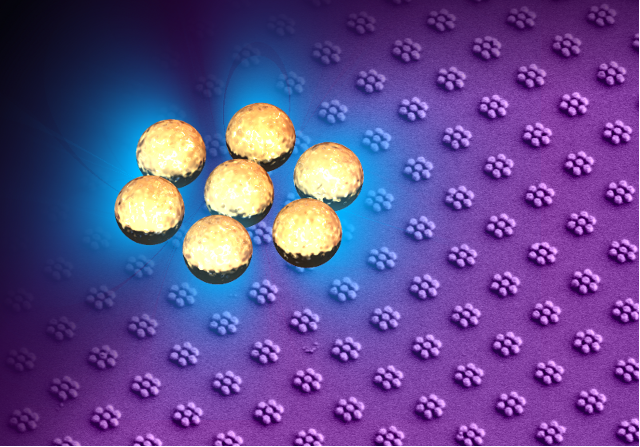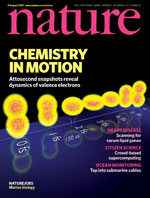
Gold heptamer structures show strong Fano resonances. The gold nanoparticles are only about 150 nanometers in diameter. (c) Sven Hein, Na Liu, Harald Giessen, University of Stuttgart, Germany.
Photonics is all about light. Processing of light for applications ranging from holograms and displays to optical telecommunications. Thanks to a better theoretical understanding and to advances in fabrication technology, photonic devices and gadgets have become increasingly versatile and powerful.
But photonics also has a dark side. In many light-processing devices and structures there are dark modes — oscillations of the light wave that while not forbidden cannot be directly excited by a given experimental configuration. In a violin for example, the strings are best sounded by drawing the bow perpendicular to their length.
However, the dark modes in photonic devices are not lost to applications. In the past months, researchers have developed new approaches that can make use of the dark modes by using interference effects with the allowed, bright modes. The resonances created by this interference are called Fano resonances, after Ugo Fano who first described them in 1961.
“Fano resonances are cool because they are the manifestations of dark modes that cannot be excited directly. In any system there are only a few bright modes but an infinite number of dark modes. The Fano resonance is the interference between a bright mode and one of the dark modes,” explains Peter Nordlander, a physicist from Rice University in Houston, Texas.
Fano resonances are very sharp, with a spectral shape that is much narrower than what can be achieved with comparable regular oscillators and their Lorentzian lineshape. This advantage makes them attractive for sensing applications. Because the spectra of Fano resonances are so narrow, the tiniest changes to the local environment of the resonator structures lead to noticeable shifts of the resonance wavelength. Even the presence of a single molecule could be detected.
[…]
Continue reading...
One of the fundamental concepts of quantum mechanics is that objects can be described as waves, whether they are electrons, atoms, light, anything really, even your cat (or that of Erwin Schrödinger). And of course, if the equations that describe their wavefunctions are identical, objects will behave in the same way. Even if they are fundamentally different physical entities.
Two papers published this week highlight just how far this analogy can go. In one study a gas of ultracold atoms behaves like electrons in a crystal, whereas in the other study the ultracold atoms show quantum effects known from laser physics. Atoms behaving like electrons as well as light.
[…]
Continue reading...
If you look at the image of an atom in a text book, it looks rather quiet and peaceful. There is a nucleus in the center made from a number of protons and neutrons. Around the nucleus the electrons typically are shown to orbit the core like planets around the sun.

Cover of the 5 August 2010 issue of Nature (c) nature publishing group
The reality, however, is far more complicated. First of all, the electrons don’t look like small planets, but are smeared out in complex shapes known as orbitals. The energy states of the different orbitals correspond to the electron shells in atomic physics. And secondly the electron motion is extremely fast, on the timescale of a femtosecond (fs), which is 10-15 seconds. This is so short that even light can’t move very far in such a short time. Within a femtosecond it travels only about a third of a micrometer. So the question is, how is it possible to take a snapshot of such a fast motion? Well, one needs to use a camera that is even faster.
This ‘camera’ is a laser with attosecond resolution. An attosecond (as) is a thousand times faster than a femtosecond. In the present case, pulses of 150 as were used. These lasers are seriously fast. So fast that the light wave in the laser pulse completes only about one cycle. A bit like a tsunami wave that consists of only one big up and downwards motion of the water. Attosecond lasers were pioneered among others by Ferenc Krausz, with the clear aim of using them to venture into the intriguing realm of attosecond science. And it is his group that has now accomplished another major feat: the imaging of electron motions in the outer orbitals of krypton atoms. Their study appears in this week’s Nature, where it was also chosen for the cover.
[…]
Continue reading...




August 24, 2010
3 Comments